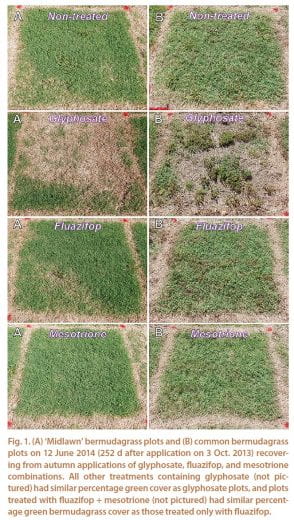(By Jared Hoyle, KSU Turfgrass Research and Extension)
Last week Ward Upham wrote an article on bermudagrass control in the KSU Horticulture Newsletter. In the article below he explains the difficulty of controlling bermudgrass, the process and the multiple applications of a non-selective herbicide.
Bermudagrass Control by Ward Upham
Bermudagrass can make a nice lawn if you don’t mind its
invasiveness and short growing season. But many people dislike both
these characteristics. Warm-season grasses, such as bermudagrass,
zoysiagrass and buffalograss, green up later than cool-season grasses
such as tall fescue and Kentucky bluegrass. They also go dormant earlier
in the fall, which can make a lawn unattractive. Bermuda that invades a cool-season lawn will be brown during much of the spring and fall while the tall fescue portion of the lawn is green. Bermuda is much more drought and heat resistant than cool-season grasses, so it will take over a cool-season lawn during the summer months if it is in full sun.
So, how do you control bermudagrass that has invaded a cool-season
lawn? Research conducted in 1996 showed that glyphosate is the best herbicide for the job. Glyphosate is a nonselective herbicide and will kill everything—
including tall fescue or Kentucky bluegrass. Therefore, you will need to
reseed treated areas. In our study, we applied a 2% solution of
glyphosate on July 15 and again on August 15 on a bermudagrass plot that
was more than 15 years old. More than one year later, we saw no
regrowth. Glyphosate works best if bermuda is growing well. The better
the bermudagrass is growing, the more chemical is taken up and pushed
into the roots. Water and fertilize if needed to get it going.
Spray about the middle of July (or when the bermuda is growing
well). Use glyphosate (2% solution). Wait two weeks and scalp the lawn
(mow as low as possible and remove clippings.) This will prevent dead
grass from covering any bermuda that starts to recover. Wait another two
weeks and spray again with glyphosate if there is any green. Wait two
more weeks and reseed. (Ward Upham)
(For the KSU Horticulture Newsletter click here – https://hnr.k-state.edu/extension/info-center/newsletters/index.html)
But during this time areas are dead, may not be acceptable and re-seeding must be done in the fall. What if you are wanting to seed in the spring (Especially if you ware wanting to convert to buffalograss)? This process might not work due to the timeline. Therefore, a couple years ago we looked into some other options and combinations for bermudagrass control. Here is a brief overview of the project.
Multiple summer applications of glyphosate are commonly recommended for bermudagrass (Cynodon spp.) control. However, this regime results in an extended period of displeasing and nonfunctional turfgrass, and is not ideal for spring establishment. An autumn glyphosate application prior to winter dormancy can control bermudagrass and may benefit spring establishment projects. However, research is needed to more precisely define the parameters of efficacious late-season herbicide applications for bermudagrass control as it transitions into dormancy. Therefore, our objective was to examine late-season bermudagrass removal using combinations of glyphosate, fluazifop, and mesotrione. Experiments were initiated in October 2013 at the Rocky Ford Turfgrass Research Center in Manhattan, KS, on mature ‘Midlawn’ hybrid bermudagrass, and at Stagg Hill Golf Course in Manhattan, KS, on mature common bermudagrass. Seven herbicide treatments containing combinations of glyphosate, fluazifop, and mesotrione were evaluated. Green bermudagrass cover (0–100%) was visually estimated when treatments were applied and every 14 d after application. Only treatments containing glyphosate reduced the green cover of bermudagrass at each site the following year. Across all ratings dates and locations, adding mesotrione, fluazifop, or both to glyphosate did not further reduce green bermudagrass cover. Overall, results indicate that a single autumn application of glyphosate prior to bermudagrass dormancy reduces bermudagrass cover the following spring. The significant reduction at spring green-up may allow turf managers to make additional applications in the spring for increased control before spring establishment.
For the full article;
Hoyle, J.A.,C. Braun, C.S. Thompson and J.A. Reeves. 2018. Late-Season Bermudagrass Control with Glyphosate, Fluazifop, and Mesotrione Combinations. Agrosystems, Geosciences & Environ. 1:180014 (2018) doi:10.2134/age2018.06.0014
https://dl.sciencesocieties.org/publications/age/pdfs/1/1/180014
***Mention of trade names or commercial products in this article is solely for identification purposes and does not imply recommendation or endorsement, nor is criticism implied of similar products not mentioned by Kansas State University.***
Don’t forget to follow me on twitter @KSUTurf.
Also, visit our facebook page www.facebook.com/KSUTurf

